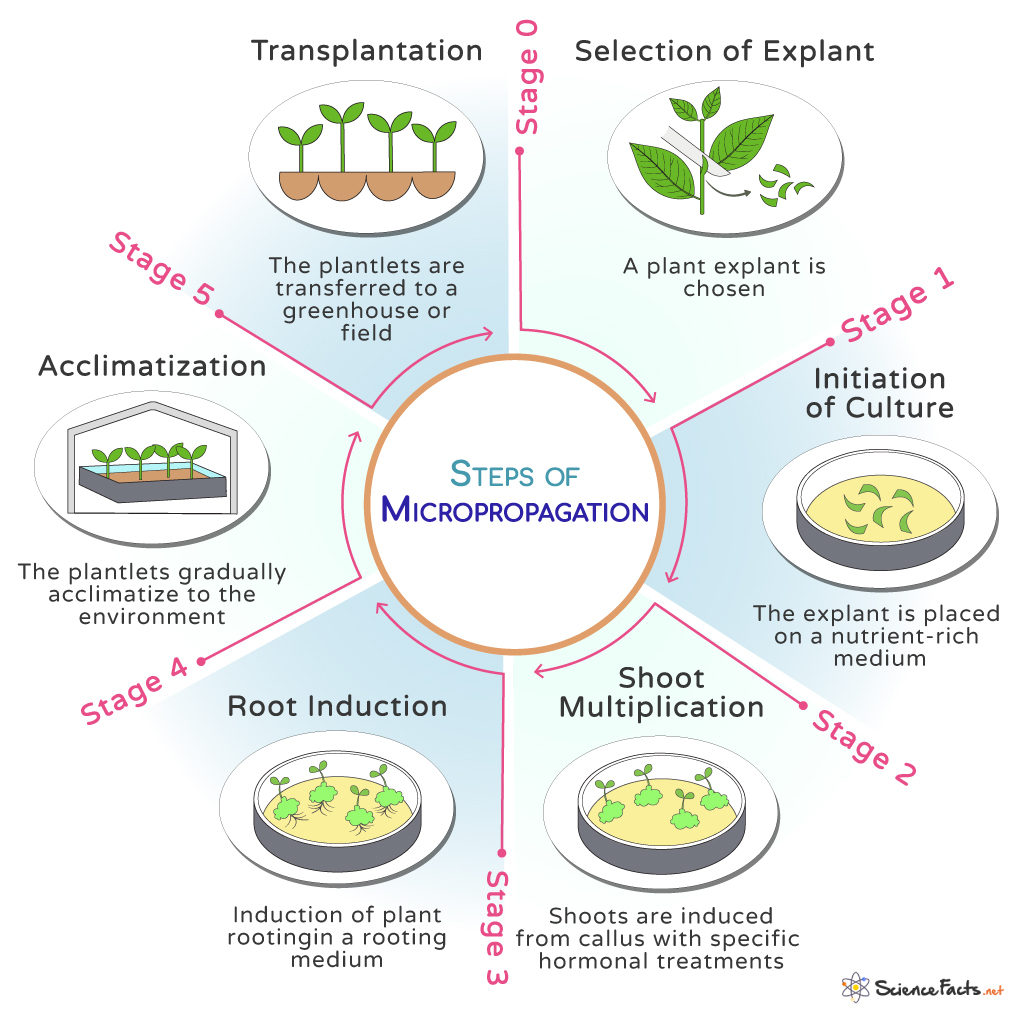The process begins with selecting a small, healthy piece of plant tissue, often called an explant, grown in a nutrient-rich medium.
Steps of Micropropagation
Methods of Micropropagation
Advantages of Micropropagation
Disadvantages of Micropropagation
Stage 0: Selection of Explant
An explant, the starting material for micropropagation is chosen from a healthy and disease-free plant. It is then thoroughly sterilized to remove potential contaminants like bacteria or fungi. Since this step occurs before the baby plant has germinated, it is marked as stage 0.
Stage 1: Initiation of Culture
The sterilized explant is placed onto a nutrient-rich medium containing essential nutrients, vitamins, and plant hormones, providing the necessary support for the growth and development of plant tissue. After initiation, the mass of undifferentiated cells, known as a callus, is formed in the early stages of micropropagation. The growing tissue is periodically transferred to fresh nutrient media, preventing nutrient depletion and maintaining a healthy culture.
Stage 2: Shoot Initiation and Multiplication
After initiation, the formation of shoots from the callus is induced by manipulating the concentrations of plant hormones in the medium. The shoots are further multiplied by cutting or dividing them, facilitating the production of more identical plantlets.
Stage 3: Root Induction
The developing shoots are then introduced to a medium containing rooting hormones, stimulating the formation of roots.
Stage 4: Acclimatization and Hardening
The rooted plantlets gradually acclimate to environmental conditions outside the laboratory, preparing them for life in the open.
Stage 5: Transplantation
The acclimatized plantlets are finally transferred to soil in a greenhouse or field, where they can grow into mature plants.
Meristem Culture
It involves the isolation and culture of the meristematic tissue, the region of actively dividing cells found at the growing shoots and roots. It is particularly effective for producing virus-free plants, as viruses often do not infect meristematic tissues.
Callus Culture
This method uses a mass of undifferentiated cells (callus) that form when plant tissues are cultured in a nutrient medium. The callus is then induced to differentiate into shoots and roots. It is beneficial for plants that are challenging to propagate through conventional means.
Suspension Culture
It involves cultivating single cells or small aggregates of cells in a liquid medium with constant agitation. Plants from single cells or cell aggregates propagate by suspension culture. It allows the production of many plantlets in a relatively short time.
Embryo Culture
Here, the embryos obtained from seeds are first isolated and then cultivated for those plants where conventional seed germination is difficult or when specific characteristics of the parent plant need to be preserved.
Protoplast Culture
It involves the isolation and culture of individual plant cells without cell walls. Protoplasts can be fused to create hybrid plants or regenerate into whole plants. This method helps overcome barriers to sexual reproduction and for creating plants with novel traits.
Rapid Clonal Multiplication
Micropropagation allows for the rapid multiplication of plants, producing large numbers of genetically identical individuals in a relatively short period. It is particularly beneficial for industries requiring mass production of uniform plant material.
Year-Round Propagation
Unlike traditional propagation methods that may be season-dependent, micropropagation can be carried out year-round. This flexibility is advantageous for maintaining a constant and efficient supply of plants regardless of external environmental conditions.
Disease-Free Plants
The stringent sterilization procedures employed in micropropagation significantly reduce the risk of transmitting diseases and pests. As a result, the produced plants are often free from pathogens, ensuring healthier crops and ornamental plants.
Preservation of Genetic Traits
Micropropagation preserves the genetic traits of the parent plant, ensuring that desirable characteristics, such as disease resistance or specific growth habits, are maintained in the propagated offspring.
Conservation of Endangered Species
Micropropagation plays a crucial role in the conservation of endangered plant species by enabling the reproduction of plants in controlled environments. It helps prevent their extinction and contributes to biodiversity preservation efforts.
Efficient Use of Space
The compact size of tissue cultures allows for efficient use of space in laboratories or controlled environments. This method is precious when space is limited or when conducting research on a large scale.
Cost and Resource Intensive
Establishing and maintaining a micropropagation facility is expensive due to the need for specialized equipment, growth media, and skilled personnel. The initial investment and the operational costs can be a limiting factor for smaller farms.
Genetic Uniformity
While genetic uniformity is advantageous in some contexts, it can cause disadvantages in others. The lack of genetic diversity makes plants more susceptible to diseases or environmental changes, as everyone has the same genetic makeup.
Accumulation of Mutation
Over time, micropropagated plants may accumulate mutations due to the rapid and repeated cell divisions. These mutations can cause variations in the propagated plants, potentially affecting their characteristics.
Somatic Variation
Somatic or genetic variation within a single plant can occur during micropropagation. It can result in differences among the propagated plants, impacting their uniformity.
Labor-Intensive Process
Micropropagation requires skilled technicians to perform explant selection, sterilization, and sub-culturing tasks. The labor-intensive nature of these tasks can increase the overall cost and complexity of the process.
Limited Success with Some Species
Not all plant species respond equally well to micropropagation. It is challenging to propagate some plants using this method, limiting its applicability in plant breeding.
